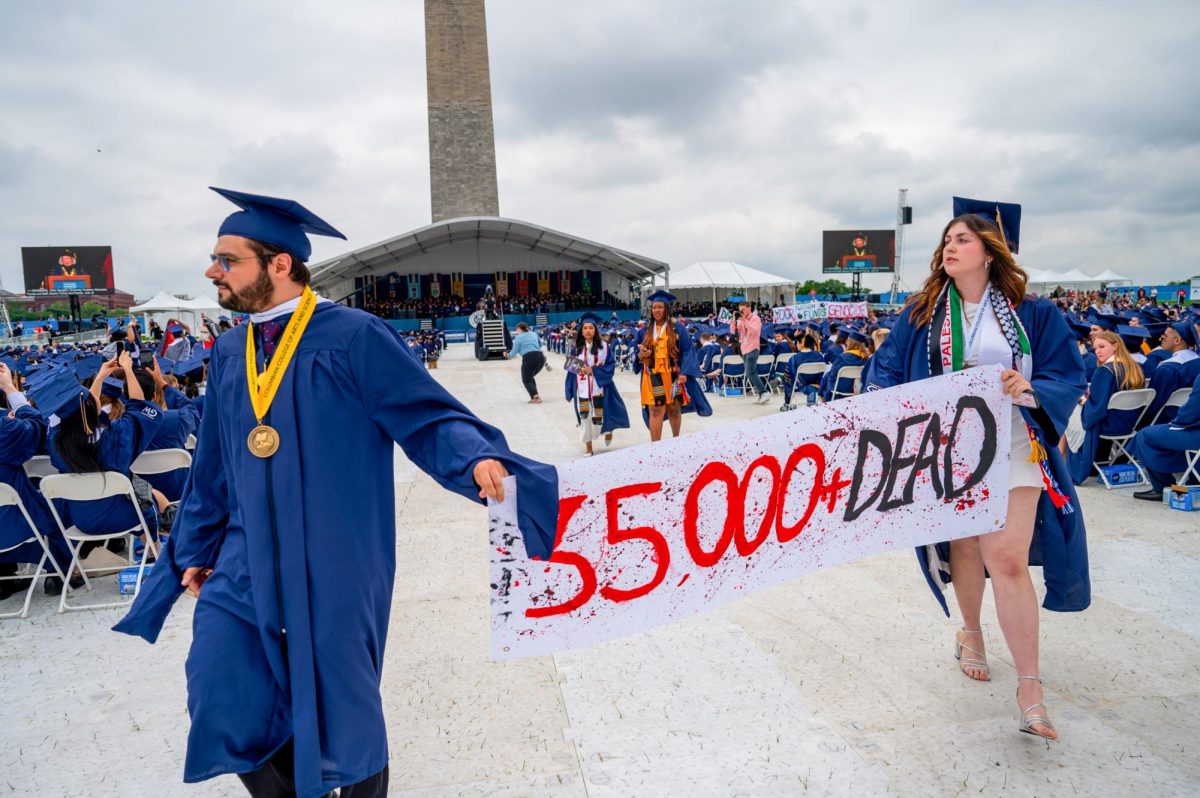The University unveiled Tuesday key pieces of a 10-year strategic plan that will retool nearly every corner of GW by doubling the number of international students and hiring up to 100 new professors.
Provost Steven Lerman told the Faculty Assembly that the more than $110 million proposal is the starting gun for a period of major investments in faculty hires, funding for Ph.D. students and new research centers. The plan will also call for new study abroad programs and more interdisciplinary work to push students and faculty into multiple fields.
The decade-long blueprint also puts a permanent stamp on several ideas already trumpeted during University President Steven Knapp’s tenure, including global growth and interdisciplinary research.
“This plan will be all about making the University something more than the sum of its parts,” Lerman said. “It’s about building greatness for the University around a common shared set of themes, a common shared vision that leverages the great aspects the University has created over the last 190 years of its history.”
Savings from the cost-cutting Innovation Task Force will support the plan, Knapp said. He founded the ITF in 2009 to brainstorm where administrative or academic dollars could be spent more efficiently.
Fundraising will also play a major role. Through gifts, the University is looking to pump an additional $200 million into the plan as it pans out.
“I think it’s an ambitious, but not at all an unreachable goal,” Knapp said in an interview after the Faculty Assembly.
Lerman, the University’s second-in-command, has spent more than a year drafting the plan, which will be presented to the Board of Trustees Oct. 19. The board will weigh in on the final proposal at its February meeting.
‘The boldest part of the plan’
The change that has generated the most buzz under the plan, Lerman said, is the move to admit undergraduates to the University as a whole – rather than to a single school. That change would make it easier for students to double-major and for faculty to draw up courses that push a set of “core competencies” for the University, he added.
It would also require admissions policy and curriculum changes, as well as an overhaul of GW’s budget model for different schools.
In an interview Wednesday, Lerman said administrators have not hashed out what the curriculum would include, but that it would complement what students already learn in their specific schools.
“By creating a university where students are doing more shopping of majors, you want to make sure there are great freshman offerings that expose students to fields that they might not know anything about. Public health isn’t taught much in high school. Engineering isn’t taught much in high school,” Lerman said.
He said he would have to work to convince faculty and deans that the University should move away from school-restricted systems.
“There are many people who think, for us, that this is the boldest part of the plan. There are those who think it’s a great idea and have unbridled enthusiasm for it,” he said. “But there are others who see it as an interesting option, but want to make sure that if and when we do this, we address some very specific concerns.”
He said the idea has been embraced by schools across the country, but added, “It’s a big change for GW, given our history.”
Schools like Stanford, Arizona State and Cornell universities already boast more interdisciplinary opportunities for professors and students.
Faculty Senate committees will begin to hammer out details this semester for a more GW-wide academic vision, a step that Knapp said would help professors “think about the University as a whole, and not just their enclave of the University.”
The interdisciplinary focus will also reach into the research arena. Lerman said GW would open several more research centers like its recent Global Women’s Institute and Computational Biology Institute.
It will pay off for students, too, said Forrest Maltzman, senior vice provost for academic affairs and planning. While 60 percent of arts and sciences students at Princeton University take engineering courses, almost none at GW do, he said.
“I would love for our engineering program to be reaching out to international affairs students and be teaching them courses that are not designed for engineers about third world engineering,” he said.
Charting a global reach
The plan’s global thrust is one of its most far-reaching components. It calls for doubling of the international undergraduate population, which sits at 7 percent, as the University looks to connect students globally and increase its revenue stream. Nearly all undergraduate international students pay full tuition.
Out of the about 2,500 international students at GW, 40 percent come from China and South Korea.
Lerman said the University has looked to Boston University’s 18 percent international student body as a model for foreign growth.
“This suggests to us that this is entirely doable. If you invest in recruiting and building your brand and reputation outside the United States, you can attract talented international students in greater numbers than we do today,” he said.
He said the international growth would push the University to add specialized housing options, more English language courses and international student services.
But the University has not set its sights on branch campuses like the ones New York University has established in the United Arab Emirates and China, he said.
GW has already been at work at some global expansion, with the GW School of Business starting a master’s of finance program in China last year and the Columbian College of Arts and Sciences now planning a global undergraduate degree that takes students from D.C. to China and France over four years.
The University will also expand its study abroad offerings, connecting students with international companies for internships and work opportunities. Lerman said GW would look toward expanding online learning options for those students working abroad so they do not fall behind on coursework.
Maltzman said the plan would rethink study abroad by putting students in more hands-on positions like “working in labs in Germany, businesses in South Korea, campaigns in Israel, and digs in Africa.”
Plans for future students
The strategic plan came under fire last month when Student Association leaders called out administrators for neglecting student life aspects of the University’s future, instead focusing largely on research and academics.
Lerman said his planning group adapted to those criticisms and fused curricular and co-curricular items to their vision.
One major change could include giving academic credit to students who lead student organizations or take part in service projects.
“We want to acknowledge that those activities are important educationally and structure them in some way so students can create a portfolio of experiences,” he said.
Maltzman also pointed to immediate student life projects, like more graduate housing and undergraduate affinity housing.
The University will also increase funding for graduate and Ph.D. students, growing the pool of grants and scholarships available for students who aid professors’ research efforts. The University’s last strategic plan in 2002 also prioritized increasing graduate and Ph.D. merit funding.
Lerman said stipends for Ph.D. students have recently stagnated, putting GW behind the schools it considers its competitors, like NYU and Northwestern.
“When one aspires to play in the big leagues, sometimes you have to put in resources that make it attractive for people to come here,” he said.






